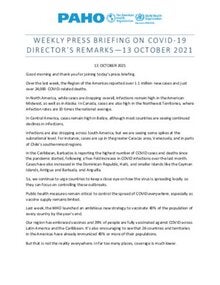Weekly Press Briefing on COVID-19: Director's Opening Remarks, October 13, 2021

|
Good morning and thank you for joining today’s press briefing. Over the last week, the Region of the Americas reported over 1.1 million new cases and just over 24,000 COVID-related deaths. In North America, while cases are dropping overall, infections remain high in the American Midwest, as well as in Alaska. In Canada, cases are also high in the Northwest Territories, where infection rates are 10 times the national average. In Central America, cases remain high in Belize, although most countries are seeing continued declines in infections. Infections are also dropping across South America, but we are seeing some spikes at the subnational level. For instance, cases are up in the greater Caracas area, Venezuela, and in parts of Chile’s southernmost regions. In the Caribbean, Barbados is reporting the highest number of COVID cases and deaths since the pandemic started, following a five-fold increase in COVID infections over the last month. Cases have also increased in the Dominican Republic, Haiti, and smaller islands like the Cayman Islands, Antigua and Barbuda, and Anguilla. So, we continue to urge countries to keep a close eye on how the virus is spreading locally so they can focus on controlling these outbreaks. Public health measures remain critical to control the spread of COVID everywhere, especially as vaccine supply remains limited. Last week, the WHO launched an ambitious new strategy to vaccinate 40% of the population of every country by the year’s end. Our region has embraced vaccines and 39% of people are fully vaccinated against COVID across Latin America and the Caribbean. It’s also encouraging to see that 26 countries and territories in the Americas have already immunized 40% or more of their populations. But that is not the reality everywhere. In far too many places, coverage is much lower. So today I want to spotlight those countries in our region that are lagging and that will require special attention to meet this 40% vaccination target. Six countries in our region have yet to reach 20% of their populations: These are Jamaica, St. Lucia, St. Vincent & the Grenadines, and Haiti in the Caribbean, and Guatemala and Nicaragua in Central America. Across all these countries, vaccine availability due to unequal distribution of doses has been a central challenge. But many of these countries are facing their own unique barriers. In Jamaica, supply delays have gotten in the way. In Guatemala, shortages of syringes have delayed immunization campaigns. In Haiti, logistical challenges continue to delay the roll out of available doses. And across the Caribbean, vaccine hesitancy among some groups remains a problem. As we have said before, vaccines will help end this pandemic and PAHO is committed to supporting every country in our region to reach and exceed these WHO targets. We’re working hard to accelerate vaccine deliveries to our region – including COVAX-procured and donated doses – especially for countries where coverage remains low. We’re supporting Jamaica, Guatemala, and Nicaragua in finalizing preparations to receive COVAX and bilateral shipments in the coming weeks. In the last few days, we fast-tracked the delivery of a total of 1.3 million doses that were donated by Spain, Germany, the United States of America, and Canada. These vaccines are being used to boost coverage in Honduras, Guyana, Argentina, and Jamaica. We’ve also been glad to see countries within our region pitch in to support their neighbors by sharing doses so we can make the most of available supplies. As more vaccine doses are making their way to our region, we urge countries to make the necessary preparations so these doses can be used as quickly as possible. Based on the lessons from across our region, we know that the success of vaccination campaigns rests on having the infrastructure in place to roll out doses at scale. So now is the time to expand cold chains and invest in health systems – especially as financial institutions and donors alike have expressed their willingness to support countries to make these improvements. And now is also the time to hire and train health workers to ensure vaccines can be administered quickly. Health workers are trusted sources of information for patients, so we encourage countries – especially those in the Caribbean, where vaccinations have been highly politicized – to train their health work force at all levels, so they have all the information that they need to answer patients’ questions and help them understand the benefits of vaccines. Finally, to be effective, vaccine campaigns must also be designed around the unique needs of the population. Thanks to the generous support of Germany and the European Union, Belize has been able to promote COVID vaccines in public spaces where people gather, such as bus terminals and markets. We have seen how stipends – even small ones for food and transport – can help incentivize campaigns in rural and remote areas, where travel to vaccination sites can be a challenge. In Bolivia, door-to-door campaigns by community leaders have helped boost coverage among rural communities, and small cash transfers have also helped incentivize more pregnant women to get vaccinated. In Brazil, we’ve seen the impact of weekend-long vaccine drives and vaccine champions to encourage everyone eligible to get vaccinated. These and other tailored strategies will be key to reaching those that we haven’t yet reached – not just in the countries where coverage remains low, but in every corner of our region. Low vaccination coverage leaves us all at risk. So, we must work together and support each other so that every country in the Americas can reach or surpass the 40% vaccination coverage target by the end of the year. The actions we take over the next three months will help us save lives, make the most of available supplies and determine our outlook for 2022.
|
